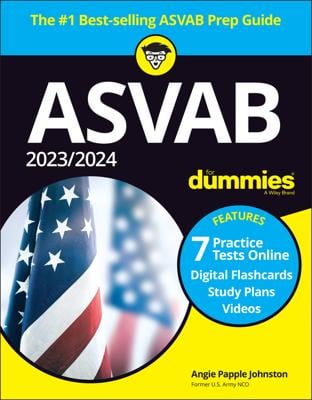2023/2024 ASVAB For Dummies (+ 7 Practice Tests, Flashcards, & Videos Online)
Explore Book Buy On AmazonDon’t let being a slow reader deter you from taking the ASVAB. Today’s military is much more complex than attending basic training, learning how to shoot a gun, and shipping off to war. After boot camp, you attend intensive classroom training to learn your military job. If you can’t read well, you’re going to have a very hard time. But the good news is that it’s never too late to work on improving your reading skills.
For many people, 13 or 22 minutes is enough time to read all the passages, understand the questions, and choose the correct answers. But slow readers may have more difficulty answering all the questions before time is up. Don’t despair: Take the following suggestions to help build your reading speed. Of course, they require work, but you knew the mission came with its challenges, right?
Read more, watch less
If you’re a slow reader, chances are you don’t do a lot of reading. If you have plenty of time before you’re due to take the ASVAB, start reading more — right now. It’s in your best interest.
You don’t have to pick up A Tale of Two Cities or War and Peace; you can start with the newspaper, a biography of a person you admire, or magazines you find at the library. (Sorry, but the instruction guide to your favorite video game doesn’t count.) You don’t need to enroll in a speed-reading course. If you devote at least one hour a day simply to reading, you’ll see your reading comprehension and speed increase within a month or so.
Several studies have shown that folks who enjoy reading as a pleasurable pastime score better on reading comprehension tests than individuals who dislike reading. Sounds obvious, right? So why study it? The idea is if you grow to enjoy reading, you’ll want to read more. You’ll become a better reader and thereby score better on reading comprehension tests. How do you discover an enjoyment of reading? Simple — choose reading material in subject areas that interest you.
Become a lean, mean word machine
People sometimes read slowly because they don’t have a large vocabulary and don’t understand everything they read. If you can identify with this situation, improving your vocabulary is your first step toward increasing your reading comprehension and your reading speed.
Keep a pocket dictionary handy while reading so you can look up words you don’t know. If you’re reading articles on the Internet, keep a window open to one of the online dictionaries (such as Dictionary.com, YourDictionary.com, or Merriam-Webster) so you can quickly find the definition of words you find confusing. Your reading will become more enjoyable, and you’ll be adding to your vocabulary knowledge to boot.
Build your confidence
Another reason people read slowly is that they don’t have confidence in themselves. They’re not convinced that they understand what they’re reading, so they read a passage several times, trying to make sure they haven’t missed anything.
But just like people who check that the front door is locked 15 times before leaving for vacation and still lie awake at night wondering whether they locked the door, reading and rereading a passage doesn’t give you confidence that you understand the text. You get confidence from proving that you understand it.
How do you prove to yourself that you understand what you’re reading? Here are a couple of tips:
Get out a textbook or reference book (preferably one that contains some subject matter that interests you) and read one or two paragraphs straight through without going back and rereading anything. Then set the book aside (keeping your place marked) and write, in your own words, a brief description of what you’ve read. Finally, turn back to the passage and compare your description to the information on the page.
Play the 20-questions game. Read an article from a magazine, reference book, or textbook. Then ask someone to pick out facts from the article and ask you questions.
Create motivation and interest by reading the daily newspaper or news magazines. Discuss the news events with your classmates, friends, or co-workers. Stronger interest equals greater comprehension.
Is your written version of the article close in meaning to the original? Are you getting most of the 20 questions correct? Do you feel comfortable discussing current events with others? If so, you understand what you’re reading, and that should build your confidence.
If not, don’t toss the book or magazine aside in frustration or go ballistic on your mom for asking you tough questions. Keep working on it, and your comprehension will improve. Do the preceding confidence-building drills a few times a day until you feel like you can read any paragraph or two and understand the content without having to reread the information.
The Paragraph Comprehension subtest tests your ability to understand what you read, not how quickly you can read it. When you sit down to take this subtest, try to go as quickly as you can without sacrificing accuracy. Being methodical in your reading isn’t a bad thing as long as you’re getting the answers right. Just try to read a little faster than normal without panicking or missing the point.
It’s better to read the paragraphs carefully and answer the questions correctly on half of the questions and guess on the other half of the questions than it is to speed through all the reading and get none of the answers right.

